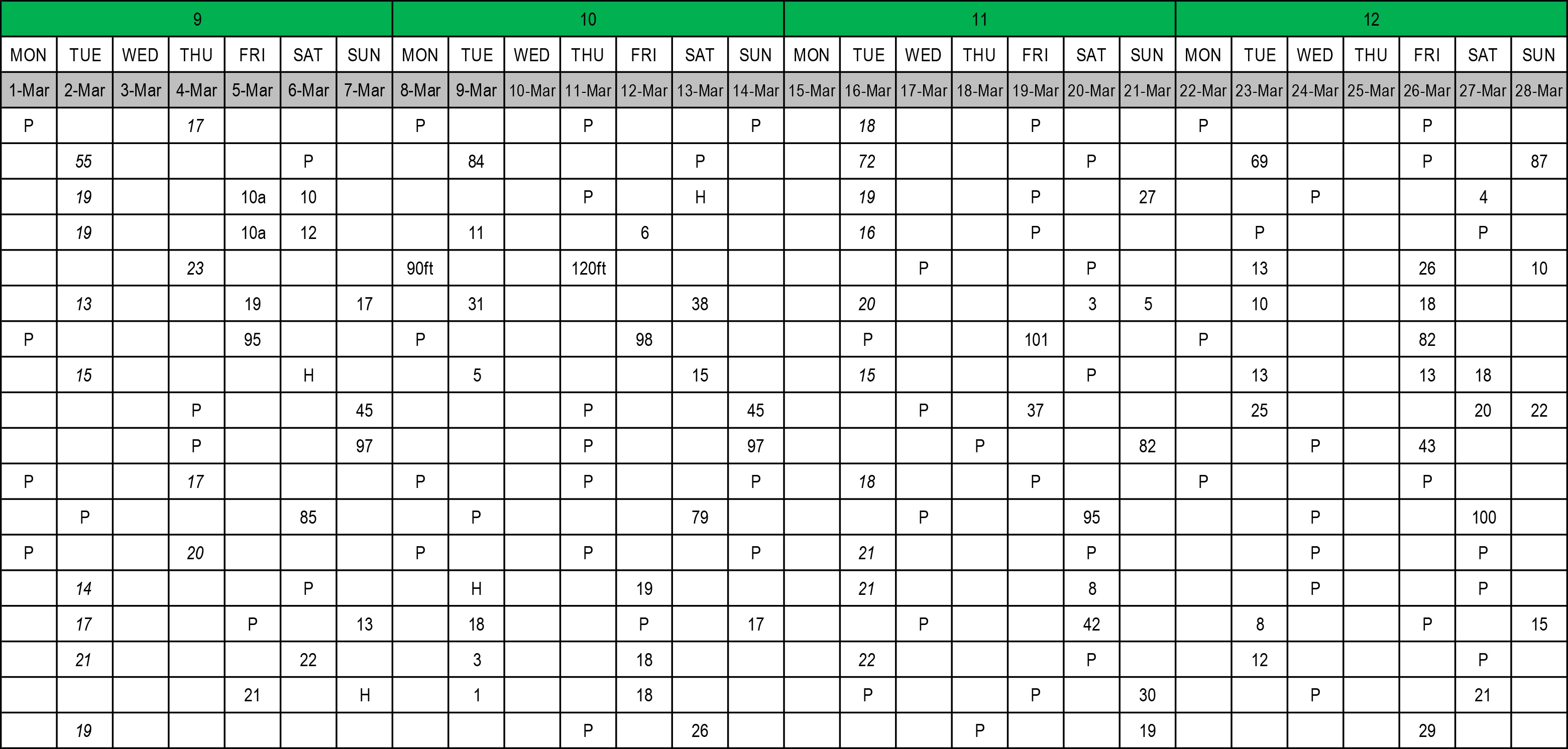Thankfully, tracking pitch counts has finally become the norm across most levels of baseball. Perhaps the most important element when it comes to developing pitchers is keeping them healthy, and tracking usage in terms of pitch counts is a major factor in that equation. However, this concept must be paired with some context for each individual pitcher. Understanding the long-term workload for each of your individual pitchers is one factor
(see Quick Pitch: Long Term Workload, November/December 2021 issue). For example, if you have players who have not rested in quite some time, there should be a heightened awareness of how they are feeling on a daily basis. Conversely, if you find out that your players are coming directly off of a rest period, they will need time to build up before bullpen work and pitch counts can become relevant.
Another piece of context for pitch counts is days of rest. As we know, each pitcher is different, and they will respond in a myriad of ways to what seems to be the same workload. And with that said, not all pitch counts are created equally: the last 25 pitches of a mercy rule game thrown from one pitcher is likely to take much less of a toll on the arm than 25 high-intent, high-stress pitches from your closer finishing a tightly contested ballgame. While on paper both of these pitchers could/should be able to take the mound again the next day, there is no guarantee that they are feeling the same.
Dual players who play a position in addition to pitching are another big challenge, and that doesn’t just apply to left-side infielders. Remember that although they don’t make as many competitive throws in a game, catchers and first basemen are constantly moving their arms in between innings and batters; a game played in one of these positions is not a “rest” day for their arms, even if they never take the mound.
Once you have an understanding of your staff’s short-term workload, you will find that some of your pitchers bounce back great the day after they throw and may feel some soreness the day after that (day two), and some of your pitchers may feel the most soreness the day after they pitch (day one) and recover progressively after that. The
Pitch Smart guidelines set forth by Major League Baseball are generally a good plan to follow when it comes to pitch counts and days of rest, but keep in mind that this program sets the maximum number of pitches allowed and the minimum days of rest as a result.
A simple daily workload chart should be kept for your players (see below). Once your pitchers are built up sufficiently to begin a bullpen progression, a plan must be laid out. During a ramp-up period before a playing season, a good rule of thumb to follow is to repeat the same pitch count in the bullpen twice before advancing higher. After that, jumping 15-20 pitches at a time is ideal, with breaks built in to simulate in-between innings. Remember that you are coaching your players, but there must be a collective effort from coaches and players to train the arm.

A couple notes for your short-term workload tracking:
- Top (green) line: running count of the week of the year
- Day of the week
- Calendar date
- You can add a line for opponent, intrasquads, etc. if you want
- Player names would go in the first column (they are cut off in this image for privacy reasons)
- ‘P’ denotes a bullpen, which can have varying levels of intensity. You can go into as much detail as you want here in terms of bullpen pitch count.
- Any other number on this chart reflects in-competition pitch count.
- Sometimes, pitchers will warm up without coming into the game. This is denoted by ‘10a’ for ’10 pitches away from being hot’ or ‘H’ for ‘hot.’
Since the average inning is around 20 pitches or so (this may vary between levels), advancing pitch counts no more than 20 at a time can help pitchers build up endurance without losing their “stuff.” Follow the Pitch Smart guidelines to maintain pitch count limits, and be very wary with your dual-position players and anyone who has pre-existing arm issues or injuries. And once the season starts, take into account that “getting hot” in the bullpen without coming into the game and warmup pitches aren’t accounted for when it comes to pitch counts––but they add up!
The bottom line: have meaningful conversations with your players. Remember that every one of them will tell you that their arms feel “good” if you just ask them how they feel. So wait until they’ve nearly completed their pregame throwing routines, and then ask them useful questions:
- How do you feel on a scale from 1-10?
- Are you feeling better, worse, or the same as [the last time you pitched?
- Where do you get the most sore? Is that normal?
- Any other nagging soreness or injuries anywhere else?
Be sure to also read "Long Term Workload – The Bird's Eye View" from the November/December 2021 Inside Pitch Magazine issue!